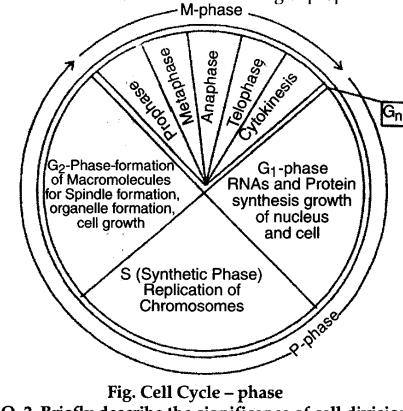Name and explain the three stages of cell cycle associated with interphase
OR
Describe the events taking place during interphase
Cell cycle : The three stages of cell cycle are : (i) Gj phase, (ii) S phase or synthetic phase and
(iii) G2 phase.
The resting stage or stage between two mitotic divisions (that is at the end of prophase and beginning of prophase) is called interphase. The interphase is the longest part of mitotic cycle taking a long time for its completion. It itself consists of three phases:
(i) Gj Phase : (Post-Mitotic Gap Period)
(a) It includes synthesis and organization of the substrate and enzyme necessary for DNA synthesis.
(b) It is marked by the transcription of r-RNA, t-RNA, m-RNA and synthesis of different protein
© Enlargement of nucleus.
(d) Pooling of nucleotide and protein from the neighbouring cell into dividing cell.
(e) The chromosomes lie in the form of more or less loosely coiled thread usually somewhat closely arranged in the membrane.
(ii) S-Phase (Synthetic phase):
(a) Replication and duplication of DNA since histones are synthesized at this time. The chromosomal and DNA replication take place ’ at this time of interphase. Chromosomes double everywhere except at the centromere. But in some cases the phenomenon is different. It stands for the largest time for interphase.
(iii) G2 Phase (Pre-Mitotic Gap period):
(a) It is the stage when rate and amount of protein synthesis is maximum important in spindle fibre protein.
(b) It is the post DNA synthesis phase during which all the metabolic activities concerning growth of cytoplasm and its constituent cell organelle and macro-molecules are formed.
Highly extended chromosome coiling of chromosome marks starting of prophase
